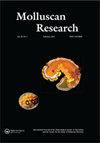Uncovering the biodiversity of New Zealand Solenogastres (Mollusca, Aplacophora) with three new species of Proneomeniidae Simroth, 1893 and new data for Dorymenia quincarinata (Ponder, 1970)
IF 0.6
4区 生物学
Q3 ZOOLOGY
引用次数: 1
Abstract
ABSTRACT Aplacophorans are vermiform marine molluscs found in benthic habitats worldwide. However, there is an extreme lack of knowledge about their true diversity. There are around 440 described species, but the true number is estimated to be at least tenfold higher. Identifying most solenogaster aplacophorans to the species, genus and sometimes even family level requires histology so that internal anatomical structures, such as the radula, foregut glands, and reproductive organs can be characterised. The aplacophoran faunas of many regions have barely been studied or have not been studied at all. An example is the waters surrounding New Zealand where only three species have been described to date. To advance the understanding of the biodiversity of Aplacophora, we describe three new species of solenogaster aplacophorans from New Zealand, all of which belong to the family Proneomeniidae Simroth, 1893: Dorymenia tanifa n. sp., Dorymenia ancora n. sp. and Dorymenia lucida n. sp. New data on Dorymenia quincarinata (Ponder, 1970) are also included and a comparison of all Dorymenia species is described in detail. In addition, DNA barcodes were obtained from D. lucida n. sp. and D. quincarinata, which will be useful for future specimen identification by non-experts and future studies on aplacophoran evolution.揭示新西兰Solenogastres(软体动物,Aplacophora)的生物多样性,包括Proeomenidae的三个新种Simroth,1893和Dorymenia quincarinata的新数据(Ponder,1970)
摘要Aplacphorans是一种在世界各地海底栖息地发现的蠕虫状海洋软体动物。然而,人们对它们真正的多样性知之甚少。描述的物种约有440种,但真实数量估计至少高出十倍。从物种、属,有时甚至科的层面上识别大多数Solenoaster aplacophorans需要组织学,以便能够表征内部解剖结构,如舌苔、前肠腺和生殖器官。许多地区的aplacophoran动物群几乎没有被研究或根本没有被研究。一个例子是新西兰周围的水域,迄今为止,那里只描述了三种物种。为了进一步了解Aplacophora的生物多样性,我们描述了来自新西兰的三个新的Solenomaster aplacophorans物种,它们都属于Proneomenidae Simroth家族,1893年:Dorymenia tanifa n.sp.、Dorymeni ancora n.sp.和Dorymeniia lucida n.sp。还包括了关于金花Dorymenia quincarinata的新数据(Ponder,1970),并详细描述了所有Dorymonia物种的比较。此外,还从D.lucida n.sp.和D.quincarinata中获得了DNA条形码,这将有助于非专家未来的标本鉴定和无孔虫进化的研究。
本文章由计算机程序翻译,如有差异,请以英文原文为准。
求助全文
约1分钟内获得全文
求助全文
来源期刊

Molluscan Research
生物-动物学
CiteScore
1.80
自引率
10.00%
发文量
27
审稿时长
>12 weeks
期刊介绍:
Molluscan Research is an international journal for the publication of authoritative papers and review articles on all aspects of molluscan research, including biology, systematics, morphology, physiology, ecology, conservation, biogeography, genetics, molecular biology and palaeontology.
While the scope of the journal is worldwide, there is emphasis on studies relating to Australasia and the Indo-west Pacific, including East and South East Asia. The journal’s scope includes revisionary papers, monographs, reviews, theoretical papers and briefer communications. Monographic studies of up to 73 printed pages may also be considered.
The journal has been published since 1957 (as the Journal of the Malacological Society of Australia until 1993). It is free to members of the Malacological Society of Australasia and the Society for the Study of Molluscan Diversity.
 求助内容:
求助内容: 应助结果提醒方式:
应助结果提醒方式:


